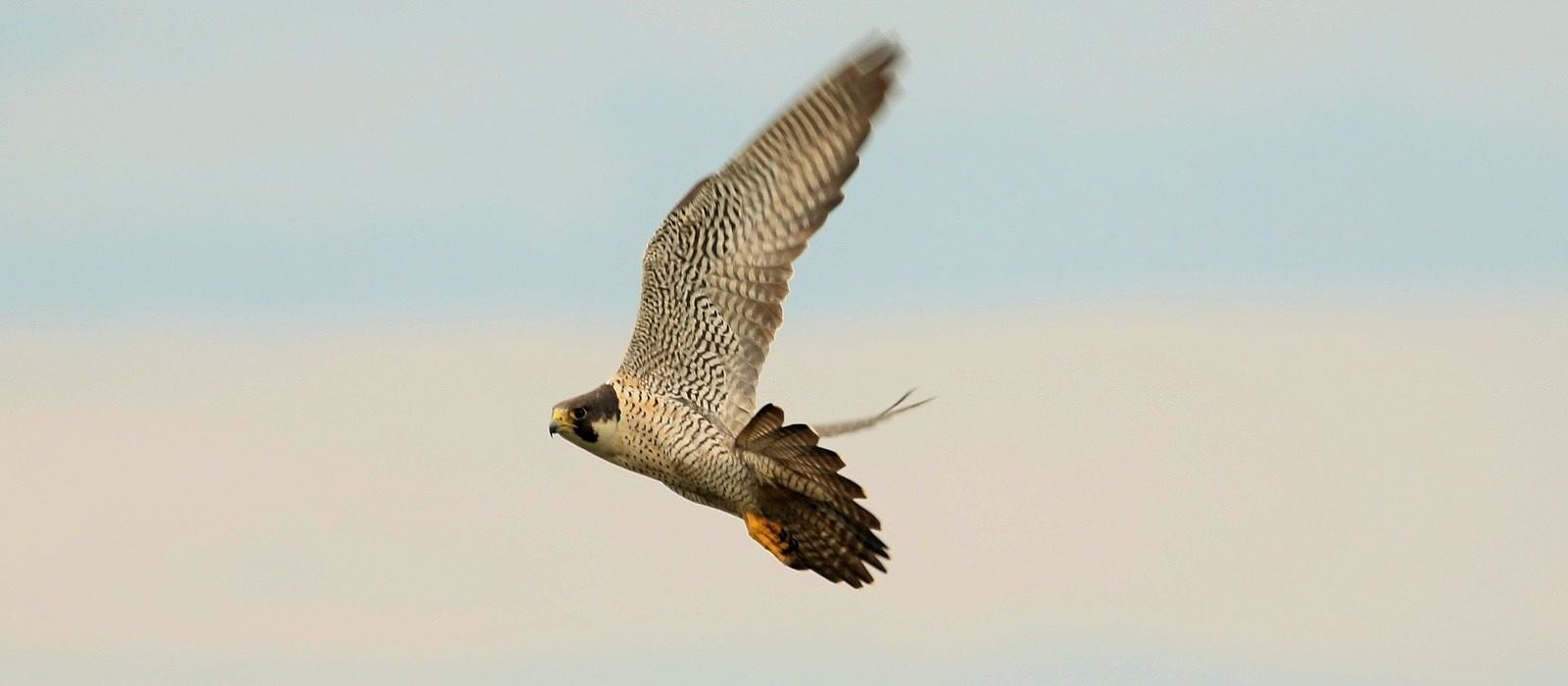A Memorable Year at the Hawk Watch
2019 marked the 15th consecutive season of raptor migration monitoring at the Pack Monadnock Raptor Observatory, located in Miller State Park in Peterborough. Between September 1 and November 21, staff and volunteers logged a whopping 557 hours of observation time, tallying 10,503 raptors from the Observatory. In addition, more than 5,700 visitors – including hundreds of students in 15 different school groups – visited the Observatory to witness the spectacle of the migration, guided by Harris Center naturalists and trained volunteers.
A Merlin pays Pack Monadnock a visit in the fall of 2019. (photo © raven.digital)
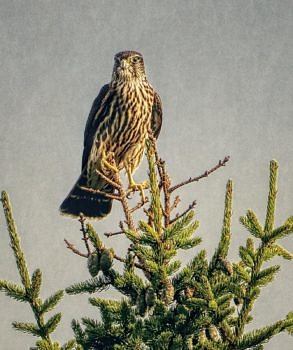
The Hawk Watch crew celebrates the 10,000th raptor of the 2019 season on October 20, 2019 at the Pack Monadnock Raptor Observatory. (photo © Francie Von Mertens)
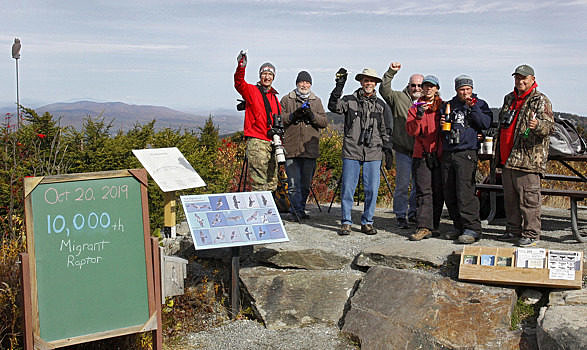
Concerning Counts
While 2019 did see an increase over 2018 in the total number of raptors observed, the telling measure of raptors-per-hour was starkly similar to last season’s paltry count. The 2019 count ended up slightly below average, but to understand the trends, it’s best to take it species by species. Total counts for the two most numerous species, Broad-winged Hawk (7,840) and Sharp-shinned Hawk (1,027), posted considerable rebounds from 2018’s historic lows. These two species represent 76% and 14%, respectively, of all birds tallied over the 15 years the Observatory has been in operation, leaving just 10% of the pie to be divvied among a dozen other species.
Migratory Osprey populations continue their plunge. A decade ago, migrant Ospreys still outnumbered Bald Eagles three to one; in 2019, increasing Bald Eagle counts finally surpassed that of this fish-eating raptor. Pack observers also documented ongoing declines in migrating Northern Harrier (a near historic low), Cooper’s Hawk, Northern Goshawk (also a near historic low), and Red-tailed Hawk numbers, strengthening the case for more research and conservation efforts on behalf of these species. While some of these declines can be tied to raptors wintering further north in recent years, some species like the Northern Harrier have seen bona fide population declines, according to statewide and regional estimates. This trend only strengthens the case for promoting the Harrier Project that New Hampshire Audubon is launching in 2020.
Raptors in flight above Pack Monadnock. (photo © raven.digital)
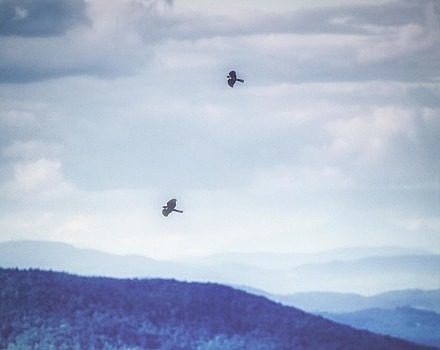
Five former Pack Monadnock raptor biologists (from left to right: Julie Brown, Henry Walters, Katrina Fenton, Chad Witko, and Levi Burford) gather for hawk watching and camaraderie in 2019. (photo © Phil Brown)

Promising Trends
Thankfully, the trends were not all negative. Peregrine Falcons (64) continue to thrive in the fall of 2019, and Bald Eagles set another record tally (180). Two traditionally more southern species, Turkey Vulture (268) and Red-shouldered Hawk (181), continued their expansion north, and the diminutive American Kestrel (185) – a species in decline over much of its range – made another strong showing. In addition to raptors, observers also counted migrating Canada Geese (1,783) and Monarch Butterflies (1,093!), topping even last year’s banner butterfly total. In total, 81 bird species were tallied from the observatory, including everything from scoters to sparrows.
Raptor Release Day
The Observatory hosted several events this fall, most notably Raptor Release Day on Sept. 22. This event was timed with International Hawk Migration Week, and fell within peak Broad-winged Hawk migration season. Sept. 22 wasn’t a great migration day, but hundreds of visitors enjoyed witnessing the release of two rehabilitated Broad-winged Hawks and learning about raptors through interpretive programs led by the Harris Center and the SCA NHCorps.
A rehabilitated Broad-winged Hawk is returned to the wild on Raptor Release Day 2019. (photo © Kim Nagy)
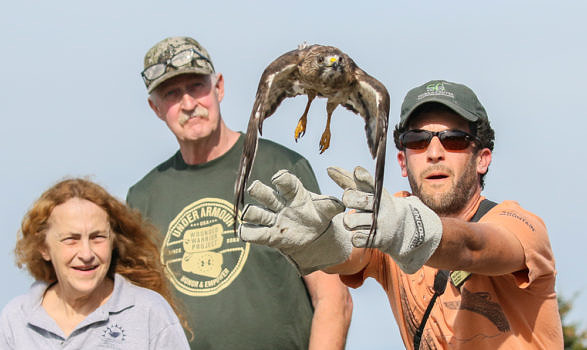
A young visitor to the Hawk Watch learns how to identify raptors by their silhouette. (photo © Ben Conant)
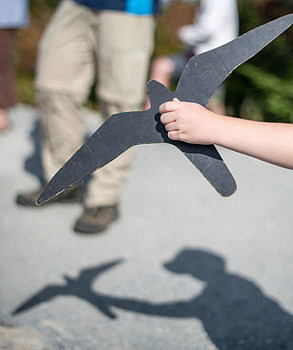
The Bigger Picture
The Pack Monadnock Raptor Observatory is part of an international monitoring effort under the umbrella of the Hawk Migration Association of North America (HMANA). Because of the site’s consistent and long-term dataset, data from Pack are included in the latest Raptor Population Index (RPI), an analysis that paints a picture of how migratory raptor populations are faring throughout the Northeast and eastern Canada. These data are particularly important for tracking migratory populations of several species of conservation concern from year to year. Stay tuned for results from the next RPI analysis, set to occur in 2020. Pack’s data are more important than ever!
Thank You
Financial support in 2019 came from the Gilbert Verney Foundation, Nature’s Green Grocer, Orchard Hill Breadworks, the Jack Daniels Motor Inn, and many individual and organizational sponsors, including sustaining donors. Miller State Park and the NH Department of Natural & Cultural Resources continue to support our work onsite, in partnership with NH Audubon. We’re also grateful to our education partner, the SCA NHCorps. Special thanks is due to Francie & Carl Von Mertens, the Harris Center’s team of volunteer educators, and to our many dedicated volunteers, sponsors, and program participants, who keep this project a vibrant community resource for all.
Learn More
For more detailed information, including an in-depth analysis and population trend graphs for each raptor species we observed, see the full report from the 2019 season.
Contact
For more information on the Pack Monadnock Raptor Observatory, please contact Phil Brown at (603) 525-3499 or by email.
